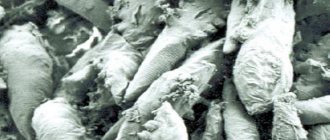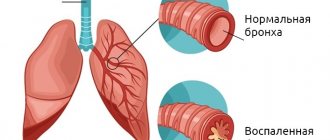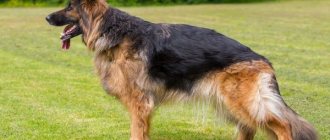The dog is breathing normally, respiratory rate is normal
During puppyhood, 60-100 breaths per minute is considered normal for a dog of any breed. But as soon as a pet turns more than three months old, not only age plays a role, but also the weight of the animal:
- 15-30 breaths per minute for small dogs;
- 10-25 – for medium breeds of animals;
- 10-20 – for large dogs;
- 8-20 – for giant-sized pets.
If the dog feels well and the respiratory rate is within the described limits at rest, then there is no need to worry. But if, at a normal frequency, the owner notices that the pet begins to wheeze or cough, then this is a reason to start looking more closely at his four-legged friend.
Attention! During physical activity and in extreme heat, the respiratory rate can reach 200 breaths per minute; this is also not a pathology.
Different causes of shortness of breath in dogs
In veterinary medicine, there are the following types of reasons why a dog has shortness of breath:
- Caused by heart problems. In severe cases, the condition manifests itself at rest and there are attacks. The animal is not active, plays little, eats poorly.
- Metabolic disorder. Appears after vitamin deficiencies, toxoplasmosis, diabetes and other diseases. The diagnosis requires clarification.
- Respiratory. The cause of shortness of breath is the respiratory organs: bronchi, lungs. Caused by infections and viruses, structural pathologies.
- Disorders of the central nervous system. There is a problem with the transmission of impulses that are responsible for breathing. An MRI is indicated. Sometimes such disorders are the cause of epilepsy in dogs. In this case, special studies are carried out and medications are prescribed. Most often this is Pexion. You can read the instructions for use at https://doktorpes.ru/katalog/peksion/peksion-100-mg/.
- Acute conditions: anemia, anaphylactic shock, heart attack.
Short-term shortness of breath after physical exertion is considered normal. When the rhythm returns to normal, it will disappear. In hot weather, your dog needs plenty of fluids and shelter from high temperatures. Overheating or intense play is prohibited for breeds with a special structure of the nasopharynx: they cannot breathe normally.
Types of shortness of breath in dogs
Most often, people begin to worry when the dog begins to experience shortness of breath in a calm state. And it doesn’t matter what genus or breed the pet belongs to, whether it’s large or small, it shouldn’t be like this. There are three options for shortness of breath:
- Inspiratory – it is difficult for the dog to inhale air due to narrowed lumens. He sticks out his tongue strongly, breathes deeply, but with a whistle or wheezing.
- Expiratory – difficulty exhaling due to problems in the bronchi. Often a symptom of bronchial asthma or bronchitis.
- Mixed - noticeable against the background of serious conditions and diseases (tumor, pneumonia, pneumothorax, etc.).
Depending on the affected organ system, shortness of breath is classified into respiratory, cardiac, central, etc.
Shortness of breath in a dog
Experts commonly refer to shortness of breath as disturbances in the frequency, rhythm and depth of breathing. In a healthy dog, these disorders may occur as a result of the animal’s compensatory reaction to the lack of oxygen in the body. This situation can be caused by a number of physiological reasons, such as:
- With increased physical activity - intense training, running, etc.
- Shortness of breath can be caused by severe obesity in a dog or poor physical fitness.
- The female may experience shortness of breath during and after childbirth.
Pathological shortness of breath in a dog is caused by a number of diseases and can be one of the symptoms of a particular disease.
Veterinary specialists divide breathing-related disorders into three main groups:
- Respiratory.
- Cardiogenic.
- Damage to the nervous system.
Of the respiratory diseases, shortness of breath most often occurs in diseases of the lungs - bronchitis in dogs, pneumonia in dogs, pleurisy in dogs, pulmonary edema in dogs, asthma in dogs.
Of the cardiogenic ones, shortness of breath is one of the symptoms of diseases of the cardiovascular system (heart defects in dogs, myocardial infarction in dogs, myocarditis in dogs).
The cause of disturbances in the functioning of the myocardium may be such a dangerous disease for dogs as dirofilariasis.
Damage to the nervous system - hemorrhages, cystic neoplasms, malignant tumors and injuries received by electric current; with cerebral edema, the center responsible for regulating the respiratory system is compressed.
In addition to the main 3 groups of factors influencing the development of shortness of breath, there are also a number of minor ones. Their influence on the functioning of the respiratory system is no less significant.
The cause of severe shortness of breath in a dog can be diseases of the endocrine system (diabetes mellitus in a dog). Disturbances in the body's metabolic processes have a sharply negative effect on all vital functions.
Shortness of breath in a dog can develop as a result of piroplasmosis (canine piroplasmosis (babesiosis).
Disturbances in the process of inhalation and exhalation are observed with the development of anemia (anemia in dogs). A deficiency of iron-containing protein in the body provokes oxygen starvation of all tissues at the cellular level. With anemia, shortness of breath in a dog is diagnosed even in a state of complete rest.
Infectious diseases accompanied by an increase in body temperature - parvovirus enteritis, infectious hepatitis in dogs, canine distemper, leptospirosis in dogs, canine adenovirosis.
Traumatic injuries to the chest and ribs also lead to shortness of breath in the dog.
Shortness of breath can be caused by stress. The release of hormonal substances provokes increased stimulation of the myocardium, increasing the overall speed of blood movement throughout the body.
Clinical picture . Dog owners note that their pet has very rapid breathing, breathing becomes labored, with visible effort when inhaling or exhaling. The dog appears in an unusual posture (front legs spread, neck extended). The dog becomes restless and does not want to lie down. The sounds of whistling and wheezing can be heard from a distance. Visible mucous membranes have a pale or bluish tint.
Diagnosis . To establish the cause that led to shortness of breath in a dog, at a veterinary clinic, specialists will conduct a clinical examination and prescribe additional tests - chest x-ray, broncho and laryngoscopy, a general clinical blood test, an electrocardiogram, and a serological blood test if a viral infection is suspected. Ultrasound examination of the heart is prescribed in extreme cases.
First aid . At home, if a dog has shortness of breath, it needs to be provided with absolute rest, the room should not be hot or cold, and a constant flow of fresh air should be provided. It is necessary to take a sick dog to a veterinary clinic as soon as possible.
Experienced dog owners, especially those whose dogs have respiratory problems, have veterinary first aid kits with the necessary set of medications for such cases. Their algorithm for providing emergency assistance is as follows:
- A decongestant drug is given orally (suprastin at the rate of 0.5 tablets per 5-8 kg of dog’s live weight). It is crushed and rubbed under the tongue.
- An immunostimulant (Gamavit, etc.) is administered intramuscularly.
- Rub the ears, chest and back intensively.
- 3-15 ml of a 10% calcium chloride solution is administered intravenously (if skills are available).
Treatment . Sometimes it is enough for a sick dog to be placed in an oxygen chamber or allowed to breathe oxygen using a mask.
Sometimes urgent surgery or artificial ventilation is required.
Depending on the reason that led the dog to shortness of breath, the actions of the veterinary specialist will be as follows:
- Hospitalization of the dog and placement in a box with oxygen supply;
- Reducing stress by administering sedatives;
- Removal of accumulated transudate between the lungs and chest cavity (thoracentesis);
- Prescribing diuretics to eliminate swelling of internal organs.
Prevention. Prevention should be aimed at the causes that cause shortness of breath in the dog.
It is necessary to promptly vaccinate your dog against viral diseases common in the region of residence.
Conduct quarterly deworming and treatment against ectoparasites.
On hot days, walk the dog early in the morning and late in the evening.
If your dog has chronic diseases of the cardiovascular and respiratory systems, be sure to show it to a veterinary clinic specialist.
Physiological causes of rapid breathing
Shortness of breath in a dog can have various causes. The safest are physiological ones, in which shortness of breath goes away immediately after the influencing factor is eliminated.
Some features of the breed
Pugs, bulldogs and piquines have peculiarities in the structure of the nasopharynx. Due to their flattened nose, they almost always hear whistling or even snoring. Owners can observe such shortness of breath in dogs in a calm state from a very early age of the pet. This causes him slight discomfort, but unfortunately nothing can be done about it.
Overheating of the animal
In the hot season, when the temperature constantly stays at 30 degrees and above, not only people suffer. Animals give off excess heat through their tongues, which is why they try to breathe more often. When the condition of shortness of breath (temperature) is eliminated, the problems stop and the respiratory rate returns to normal.
Important! In hot weather, you need to give your animal plenty of water to drink, otherwise even rapid breathing will not help him save himself from heatstroke.
When traveling in a car
In a car at any time of the year, the temperature rises quickly, and the circulation is weak. Therefore, dogs begin to breathe more often in order to lower their own body temperature and avoid overheating. Also, for some animals (small and timid), travel can be stressful. Then the pet not only breathes frequently, but also shakes.
Rapid breathing in pregnant and lactating bitches
Bearing offspring, childbirth and the postpartum period are very stressful for the animal. As a result, the dog may breathe a little more quickly. If she doesn't look bad, doesn't whine and eats normally, then there's no need to worry. In lactating bitches, shortness of breath can be caused by eclampsia. Against the backdrop of a drop in glucose and calcium, convulsions develop, breathing quickens, and the animal trembles. In this case, it is better to call a doctor or take the dog to the clinic.
Attention! If assistance is not provided, the dog may develop asphyxia (suffocation).
Causes of rapid breathing in dogs: should you worry?
Mild breathing problems can be quickly resolved without visiting a doctor. What factors may cause an animal to inhale loudly and frequently with its tongue hanging out?
The factors that can cause breathing problems are very extensive, so they need to be considered in more detail.
Signs of normal breathing in pets are a closed mouth and absence of sounds. Under optimal conditions, the animal takes 10-30 breaths per minute.
In some cases, rapid breathing is the norm, as it is inherent in a given breed of dog, such as Labrador, Spitz, etc. Let's look at some of them.
Colds, tumors and other possible causes of heavy breathing and wheezing
If your dog is breathing heavily, this may be due to a pathological condition:
- common cold;
- pulmonary edema;
- respiratory cancer;
- tumors in the respiratory organs;
- growths in the nasopharynx;
- ascites – accumulation of fluid in the abdominal cavity;
- hypothyroidism is a disease of the thyroid gland;
- diabetes;
- poisoning by toxic fumes or chemicals;
- obesity;
- lung helminths.
Only a veterinarian can determine the exact cause based on examination and tests.
After surgery and anesthesia
Pain and fever are not uncommon after surgery. Against their background, you can notice shortness of breath in the dog, the cause and treatment of which should be monitored by a doctor. Most often, this is a normal process of recovery and relief from stress. But sometimes something may bother your pet and then you need to find out what’s wrong.
Effective treatment for shortness of breath in dogs
Treatment is carried out taking into account the cause. If the problem with the respiratory system is due to a virus, antibiotics and immunostimulants are needed. Allergic shortness of breath is relieved with antihistamines. But every owner needs to know what to do if a dog has shortness of breath due to a heart attack.
In this case, you should immediately call a veterinarian with a resuscitation kit. During this, open the windows to provide access to fresh air. Place Suprastin under your tongue. These measures slightly restrain the attack. You can massage the ears, back, and keep your pet conscious.
In emergency situations, inject an injection of potassium chloride from 3 to 15 ml or Gamavit. If you know your pet is suffering from heart problems, keep a resuscitation kit nearby at all times. The disease requires a special daily regimen, nutrition and support with antibiotics and medications for the proper functioning of the organ.
Pathologies of the central nervous system
A number of central nervous system pathologies can cause shortness of breath:
- head injury;
- tumors;
- hematomas;
- electric shock;
- improper conduction of impulses due to illness.
Severe stress or painful shock can also contribute to rapid breathing.
Cardiogenic
With heart disease or heart failure, the first symptoms will be noted during walking or physical activity. At night the animal will breathe calmly. But as the disease progresses, the owner will notice breathing difficulties even at rest.
Respiratory
This group includes any pathologies associated with the respiratory tract:
- pneumonia;
- bacterial or viral infection;
- pleurisy;
- rib fracture;
- tumor neoplasms.
For any pathology, treatment cannot be delayed. And the very first symptom (shortness of breath) should force the owner to take the dog to the veterinarian.
Allergic reaction
Allergies that manifest as shortness of breath most often occur to medications or chemical agents. It needs to be treated with antihistamines. If this is not done, the dog may develop swelling that will completely block the airways.
Video about shortness of breath in dogs
Shortness of breath is a breathing disorder and a physiological reaction to oxygen starvation of the body, manifested by frequent, compressed, jerky breaths with an open mouth. A dog's breathing with its mouth open may have understandable reasons that do not threaten the life and health of the pet. Severe shortness of breath in a dog, which is pathological in nature, is a consequence of the disease and an accompanying syndrome.
Important! All diseases that cause severe shortness of breath cannot be diagnosed, much less cured, exclusively at home. If you notice any alarming symptoms, be sure to contact your veterinarian.
In a global sense, the causes of shortness of breath in dogs can be divided into several groups.
Respiratory – diseases, injuries, infections, disruption of internal organs. Necessary: first aid, symptomatic relief, oxygen therapy, extensive treatment.
Pathology of the central nervous system – disruption of brain function, hematomas, cysts, tumors, electrical injuries. A reliable method of diagnosis is MRI, in the absence of equipment, an algorithm, as in the case of cardiogenic nature.
Metabolic disorders - toxins that are not removed from the body have a detrimental effect on the circulatory system (diabetes), the genitourinary system (toxicosis due to renal failure), and the liver (insufficient purification and enrichment of the blood). Special risk group, complications after piroplasmosis. It is necessary to do blood and urine tests, ultrasound, and liver tests.
When rapid breathing should alert you
If the owner is not sure what caused the pet’s rapid breathing, then you need to start monitoring him. Signs that should alert a dog owner are:
- anxiety, aggressiveness;
- cough, especially at night;
- stretching the neck while breathing;
- belly breathing;
- the animal often sits rather than lying or standing to make it easier to breathe;
- foam comes from the mouth;
- hoarse barking.
If any of these signs, as well as the absence of a physiological factor, it is better to show the dog to a doctor. Treating yourself is not an option, since you must first determine the cause of strange breathing.
What does the veterinarian do?
Immediately at the appointment, the doctor examines the dog, palpates the chest, and asks about its behavior in recent days. Then he prescribes a diagnosis depending on the suspected cause of shortness of breath:
- general and biochemical blood test;
- analysis for worms;
- X-ray of the lungs and nasopharynx;
- ECG;
- Ultrasound of the abdominal cavity;
- oxygen level monitoring.
After diagnosis, it becomes clear why the dog has shortness of breath. Then the doctor either prescribes medications or immediately administers infusion therapy. In case of injury or tumor, surgery may be required.
Types of cardiac examinations in dogs
The therapist will refer you for a cardiological examination after the initial examination of the pet.
- Auscultation of the heart using a stethoscope is a simple effective method used for initial diagnosis. Also applies:
- echocardiography - ultrasound of the heart, allows you to evaluate the geometry of the organ, valve function and blood flow;
- electrocardiography (ECG) – to assess the electrical activity of the dog’s heart;
- tonometry – takes blood pressure readings;
- X-ray – allows you to see tumors in the heart and surrounding areas.
If heart problems can be caused by helminths, serology will confirm this. Depending on the hypothesis, the doctor chooses diagnostic methods.
An appointment with a cardiologist for your pet is offered at the veterinary clinic of Doctor Zarubin in Rostov-on-Don.
With modern equipment and experienced specialists, we will diagnose the problem and select the appropriate treatment.











